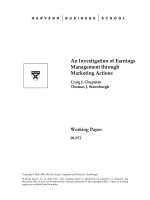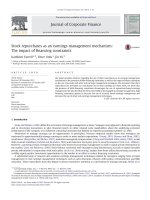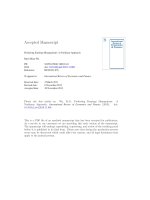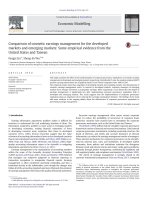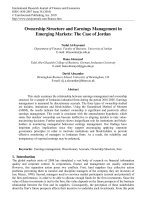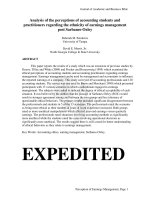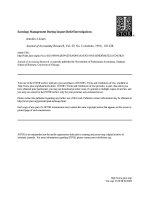Earnings management thesis
Bạn đang xem bản rút gọn của tài liệu. Xem và tải ngay bản đầy đủ của tài liệu tại đây (1.57 MB, 72 trang )
Earnings management through accrual-based
analysis
Case study: Stockmann Oy Abp from 2005-2014
Lua Luong Thi
Degree Thesis
Degree Programme
2015
Förnamn Efternamn
DEGREE THESIS
Arcada
Degree Programme:
INTERNATIONAL BUSINESS – BBA11
Identification number:
Author:
Title:
4889
LUA LUONG THI
Earnings management through accrual-based analysis
Case study: Stockmann Oy Abp from 2005-2014
Supervisor (Arcada):
Thomas Finne
Commissioned by:
Abstract:
Earnings management emerges from accounting discretion that managers allowed to decide for company. Earnings management is extremely hard to detect and there has not
been an ultimate method to detect earning management thoroughly. The thesis seeks to
provide general knowledge about earnings management and attempts to apply certain
theories and accruals models proposed by researchers (e.g. Jone 1991, Spohr 2004 and
Friedlan 1994) to the case study of Stockmann Oy Abp. The literature review is collected
from books and major studies (e.g. articles, journals, and working paper) by experts from
the field. In the case study, the author decided to conduct an analysis to detect signs of
earnings management of Stockmann Oy Abp during financial year 2005-2014 through
accruals-based analysis. First of all, the author looks into total accruals and discretionary
accruals level over 10 year period. Then based on cash flow analysis, the author reasons
her choice of further analysis of financial year 2007-2010.
The result showed that total accruals of Stockmann fluctuated widely over 10-year period, and discretionary accruals estimation indicated that during fiscal year 2006-2014,
managers have deliberately increased/decreased earnings. In addition, from cash flow approach, financial year 2007-2010 were bought into further analysis. However, detailed
break-down of financial statements showed that the divergence in trends of operating
cash flows and net income mostly was the result from expansion projects company employed. In addition, manager‟s incentive to deflate earnings is not strong enough to justify
author‟s suspicion. In a nutshell, the author could not find any indication of earnings
management through accrual analysis based on information on consolidated financial
statements provided by the company. However, the result contains some limits and is
open to further discussion.
Keywords:
Number of pages:
Language:
Date of acceptance:
Earnings management, Stockmann, accrual, cash flow, net
income, financial statement,fianncial accounting
72
English
CONTENTS
1
2
Introduction.......................................................................................................... 8
1.1
From the famous Enron scandal ................................................................................... 8
1.2
To author’s interest in thesis topic ................................................................................. 8
1.3
Aim of study ................................................................................................................... 9
Literature review .................................................................................................. 9
2.1
Financial statement disclosure ...................................................................................... 9
2.1.1
The need of financial statement ............................................................................ 9
2.1.2
Users of financial statements .............................................................................. 10
2.1.3
Qualitative characteristic of Financial Statements .............................................. 11
2.2
Accrual accounting and judgment in financial reporting .............................................. 12
2.2.1
Cash accounting and accrual accounting............................................................ 12
2.2.2
Accounting principles in accrual accounting ....................................................... 13
2.2.3
Net income: the bottom line ................................................................................. 15
2.3
Earnings management ................................................................................................ 16
2.3.1
Definition .............................................................................................................. 16
2.3.2
Researches about earnings management .......................................................... 16
2.3.3
Earnings management versus Earnings quality .................................................. 17
2.4
Managers’ incentive of earnings management ........................................................... 18
2.4.1
Bonus scheme ..................................................................................................... 18
2.4.2
Debt covenant ..................................................................................................... 18
2.4.3
Political cost ......................................................................................................... 19
2.4.4
Stock related motives .......................................................................................... 19
2.4.5
Managers’ reputation ........................................................................................... 19
2.5
Patterns of earnings management .............................................................................. 20
2.5.1
Big bath ............................................................................................................... 20
2.5.2
The cookie jar reserve ......................................................................................... 22
2.5.3
Creative acquisition accounting ........................................................................... 23
2.5.4
Revenue recognition............................................................................................ 23
2.6
Real earnings management ........................................................................................ 23
2.6.1
Real earnings management technique................................................................ 24
2.6.2
Accrual-based earnings management ................................................................. 25
2.7
Earnings management through specific accrual account............................................ 26
2.7.1
Accounting choices toward inventory: ................................................................. 26
2.7.2
Accounting choices toward long term assets ...................................................... 28
2.7.3
Allowance for doubtful account ........................................................................... 29
2.8
Accrual-based earnings management analysis .......................................................... 29
3
2.8.1
Balance sheet approach ...................................................................................... 29
2.8.2
Cash flow approach ............................................................................................. 31
Methodology ...................................................................................................... 32
3.1
Research strategies..................................................................................................... 32
3.2
Data collections ........................................................................................................... 33
3.3
The credibility of research findings .............................................................................. 33
3.3.1
Reliability ............................................................................................................. 33
3.3.2
Validity ................................................................................................................. 34
4
Limitations ......................................................................................................... 34
5
Case study: accruals analysis in Stockmann’s financial statements (2005-
2014) .......................................................................................................................... 35
5.1
Business profile ........................................................................................................... 35
5.1.1
Main merchandise sectors .................................................................................. 36
5.1.2
Major divisions over 10 years .............................................................................. 36
5.1.3
Customer markets ............................................................................................... 39
5.1.4
Loyal Customers .................................................................................................. 39
5.1.5
Stockmann’s strategy from 2005 to 2014 ............................................................ 40
5.1.6
Risks from its business profile ............................................................................. 40
5.1.7
External factors that affect the business ............................................................. 41
5.2
Financial profile ........................................................................................................... 42
5.3
Conclusion from company general analysis ................................................................ 45
5.4
Earnings management analysis .................................................................................. 45
5.4.1
Accounting policies change ................................................................................. 45
5.4.2
Earnings management from total accrual analysis ............................................. 46
5.5
Accruals analysis ......................................................................................................... 47
5.5.1
Financial year 2007 ............................................................................................. 49
5.5.2
Financial year 2008 ............................................................................................. 51
5.5.3
Financial year 2009 ............................................................................................. 56
5.5.4
Financial year 2010 ............................................................................................. 57
5.5.5
Summary from accrual analysis .......................................................................... 58
5.6
Matching against manager’s motivation to manage earnings ..................................... 58
5.6.1
Bonus scheme ..................................................................................................... 58
5.6.2
Debt covenant ..................................................................................................... 59
5.6.3
Stock price relative .............................................................................................. 59
5.7
5.7.1
Conclusion and suggestions for further studies .......................................................... 59
Conclusion from accruals analysis and manager’s incentive to manage earnings
59
5.7.2
Suggestions for further studies ............................................................................ 60
References ................................................................................................................ 62
Appendices .................................................................................................................. i
Apendix 1.................................................................................................................................... i
Apendix 2.................................................................................................................................... i
Apendix 3.................................................................................................................................... ii
Apendix 4.................................................................................................................................... ii
Apendix 5................................................................................................................................... iii
Figures
Figure 1: Criteria for realizable revenue (Palepu et al. 2003, pg.222) ........................... 13
Figure 2: Criteria for recognizable expense (Palepu et al 2003, pg. 250) ...................... 14
Figure 3: Example of big bath (Stice et al 2010, pg.293) ............................................... 21
Figure 4: Operating choices versus accounting choices‟ effect on net income statement
(McKee 2005, pg.5) ........................................................................................................ 24
Figure 5: Component of total accrual (Spohr, 2004) ...................................................... 30
Figure 6: Stockmann new structure starting from 2015 (Stockmann, 2014).................. 37
Figure 7: EPS and dividend per share paid from 2005-2014 (Stockmann 2005-2014) . 42
Figure 8: Revenue over 10 year (Stockmann 2005-2014).............................................. 43
Figure 9: Test of earnings management (Healy and Walen 1998) ................................. 46
Figure 10: Discretionary accruals (2006-2014) .............................................................. 48
Figure 11: Net income (earnings) and Operating cash flows trend (Stockmann 20042014) ............................................................................................................................... 49
Figure 12: Stockmann‟s trade receivable 2008 in million euros (Stockmann 2008) ..... 52
Figure 13: Cash flows from operating activities in million euros (Stockmann 2008) ... 53
Figure 14: Stockmann income statement 2008 in million euros (Stockmann 2008) ..... 54
Figure 15: Other operating expense in million euros (Stockmann 2008) ...................... 55
Figure 16: Finance income and expense in million euros (Stockmann 2008)................ 56
Tables
Table 1: Accrual-based earnings management (Accrual-based EM) versus Real earnings
management (Real EM) .................................................................................................. 25
Table 2: Changes in merchanside sectors (Stockmann, 2005 - 2008, 2014)* Data on
2014 in fashion sector contained both fashion and cosmetics. X: discontinued division
........................................................................................................................................ 36
Table 3: Gross margin (% of revenue) (Stockmann 2005-2014) ................................... 43
Table 4: Cash and cash equivalent in million euros (Stockmann 2005-2014) ............... 44
Table 5: Stockmann long term financial targets (Stockmann 2010) .............................. 44
Table 6: Adjusted accruals component due to accounting error (Stockmann, 2010.
Numbers are in million euros ......................................................................................... 46
Table 7: Total accruals(in million euros) and discretionary accruals ratios ................... 47
Table 8: Changes (%) in sales, inventories, receivables in 2007 excluding that of Lindex
(Stockmann 2007) .......................................................................................................... 50
Table 9: Changes (%) in Sales, Inventories and Receivables 2008 (Stockmann 2008) . 51
Table 10: Changes (%) in sales, inventories, receivables in 2010 (Stockmann 2010) ... 57
FOREWORD
I would like to take this opportunity to express my gratitude to my beloved family, for
their unwavering love and support through every stage of my life. Especially, to my
parents, I cannot imagine how my life would be without the unconditional love and
sacrifice I have been receiving from them all these years.
I also want to thank my best friends in Viet Nam and in Finland, for staying beside me
through thick and thin, for comforting and encouraging me when I am away from home.
I am also indebted to my supervior, Mr. Thomas Finne, for his guidance through all the
progress of my thesis.
Lastly, I would like to thank Ms. Hanne Klasson, for her generous help that she has
offered me during my final year at Arcada.
Helsinki, April 2015
Lua Luong Thi
1 INTRODUCTION
1.1 From the famous Enron scandal
In 2001, Enron Corporation began twenty-first century with huge accounting scandal
shook up not only the accounting system in the United State but also all over the world.
Before the scandal, the company used to be the 6th largest energy company in the world
and was recognized as “America‟s most innovative company” by Fortune, from 1996 to
2001. Company‟s shares hit all time high at $90.75 on August 2000 before collapsing to
only $0.67 on the first month of 2002. Further investigation charged Enron‟s executives
guilty for fraud, conspiracy and insider trading. The company was accused of providing
poor financial reporting, in which profit was aggressively inflated and billions of debts
as results from loss in investing activities was hidden from balance sheet. The collapse
of the company resulted in $74 billion loss for investors and thousands of employees
lost their pensions and their jobs. Further investigation showed how companies exploited accounting loopholes and creative accounting to manipulate reported financial figures. The company once again raised concern over the quality of earnings and earnings
management. The Sarbanes-Oxley Act, which provided new standards for U.S company
board, public management and accounting firms, was established as authorities reacted
to the accounting scandals, especially after Enron case.
1.2 To author’s interest in thesis topic
Together with Enron, worst accounting scandals appeared to have all manipulated their
financial reports, especially through fraudulent acts to inflate earnings and sales. Despite the fact that authorities attempted to provide more elaborate accounting guides to
mitigate those incidents, there are always room for managers to practice their own
judgments in preparing financial reports. Earnings management which emerges from
those judgments is a prolonged topic of interest among researchers. Even though earnings management is a complicated issue, the author wishes to trigger awareness about
this issue at early stage. In this bachelor thesis, the author proposes the thesis topic:
8
“Earnings management through accrual-based analysis: Case study: Stockmann Oy
Abp from 2005-2014”
In which the author attempts to answer research question:
“Can total accruals analysis detect signs of earnings management in Stockmann during
fiscal year 2005-2014?”
Sub-questions:
o Are there any abnormal accruals in Stockmann‟s financial reports?
o Are managers‟ incentives to manage earnings consistent with the abnormal accruals reported?
1.3 Aim of study
The thesis topic seeks to raise basic awareness of earnings management concept for accounting students at bachelor level. It also serves as a foundation study for the author
and her peers, who wish to continue their researches in the topic later at higher studies.
Stockmann case study is analyzed by applying theoretical framework into real-life practice. The ultimate objective of the case study is to find out, through accruals analysis,
indications of earnings management in Stockmann during fiscal year 2005-2014, especially during financial year 2007-2010. From figures conducted from published financial reports and annual reports and basic accruals theory studied by previous researches,
the author will discuss and answer research questions and its sub-questions in order to
deduce the final conclusion.
2 LITERATURE REVIEW
2.1 Financial statement disclosure
2.1.1 The need of financial statement
Accounting is important, as Horngren et al (2012, pg.26) call it “the language of business”. To be specific, accounting serves as an aid to communicate effectively between
various departments within a company, as well as with external parties. Accounting is
needed since the moment a business starts because it helps transform raw data into
9
standard form of report is understandable and comparable within a company or within
other companies in an industry. Aside from presenting financial information about past
transactions, the accounting system also serves as a useful tool for users to forecast
business‟ future. Financial accounting, along with management accounting, is one of the
two fields in accounting. Financial accounting produces financial statements for outside
audiences. Financial statements can be simply perceived as business documents that report on a business‟s condititon in monetary term (Horngren et al 2012, pg.2). The whole
sets of financial statements are balance sheet, income statement, cash flow statement
and notes and explanatory materials to the account. However, it is hard for normal people to get financial statements from private companies, only listed companies are required by law to publish their financial statements. One needs to understand what each
item in financial statements is, and it is important to deduce the meaning its number.
Hence, financial statement analysis technique is especially needed.
Financial statements are prepared under each country‟s general accepted accounting
principles. However, the increase in cross-border trading activities has urged regulators
to create a united set of accounting rules for easier management. Despite the fact that
there has not been an ultimate accounting standard yet, international firms usually adopt
the United State General Accepted Accounting Principles (hereinafter U.S GAAP) and
the International Financial Reporting Standards (hereinafter IFRS).
In 2002, the European Union (hereinafter EU) required that all EU companies, which
were listed on regular market adopt IFRS in their financial statements starting in 2005.
(Deloitte, 2013)
2.1.2 Users of financial statements
For large companies especially those that are listed on stock market, the published
financial statements are mandatory and they serve various types of users such as:
o Company executives: they need an overall financial condition of the company in
order to manage the company more effectively and suggest future plan for the
company‟s growth. Internal managers have more insight information in managerial accounting; however, they also need to understand thoroughly financial
statements since financial statements represent to public as the overall face of
the company.
10
o Shareholders: are people who will benefit from their investment if the company
is doing well and who will suffer loss if the company fails to meet expectation.
By reading financial statements, shareholders can get general information such
as revenue and profit of company throughout the year and decide whether to
continue keeping their shares in company.
o Trade partners such as suppliers who provide raw materials/inventories to the
company on credit and customers who purchase the goods/services provided by
the company. Suppliers want to know if the company is able to pay its debts
while customers need to ensure that company is a reliable supplier (ACCA F3
2013, pg. 198).
o Financial institutions (banks, insurance companies, and so on): Information from
financial statements are accessed by financial institutions in order to check
whether company meets debt covenant and whether company is able to pay back
their debt fully in the future.
o Tax authorities want to know about company‟s profit in order to assess the tax
payable that the company is due to pay.
o Company‟s employee also needs to know about the current status of their company because their future depends on it.
o Analyst experts need information for their clients who need consulting service
before they invest in a company.
2.1.3 Qualitative characteristic of Financial Statements
Financial statements in a nutshell are utmost resources that investors can obtain
from the company. There are four main qualitative characteristic for accounting information, which are:
o Comparability: accounting information from financial statements must be comparable with information from its previous periods statements or from other
companies that apply the same accounting policy
o Understandability: Though it is important for users to have a strong knowledge
of accounting and background information about the company, financial statements must be prepared in a way that users can understand. For this qualitative
characteristic, authorities have seeking to reduce the unnecessary complexity of
11
financial statement. However, many critics still claim that this matter has not
been thoroughly fixed. In PWC‟s discussion paper in 2011 entitle “Point of
view: reducing complexity: our proposal to address this challenge”, authors
pointed out that it was hard for audiences to comfortably understand and optimize financial information because of complexity in financial reports. The negative effect from this issue could cost investors and companies a lot of money.
The paper also proposed some solutions for this issue such as developing key
principles, establishing advisory committee, and converging international financial reporting standards.
o Relevance: Financial statements are relevant when information users are able to
use information from those reports for decision making (ACCA F1 2013, pg.
200). According to Conceptual Framework for Financial Reporting 2010 issued
by International Accounting Standards Board (2010) (hereinafter IASB), materiality is mentioned as an aspect of relevance. Information is said to be material if
decision made by users will be affected greatly without them.
o Faithful representation: IASB (2010) proposes to replace “reliability” with
“faithful representation”. Faithful representation reflects accurately information
it is supposed to present. According to Conceptual Framework for Financial
Statements 2010 QC12, complete, neutral and free from error are three characteristics of faithful representation.
2.2 Accrual accounting and judgment in financial reporting
2.2.1 Cash accounting and accrual accounting
There are two accounting basis: cash-basis accounting and accrual accounting. Cashbasis accounting records revenues only when cash is received and records expenses only
when cash is paid (Wild et al. 2011, pg.95). Apparently there are no receivable, payable
and depreciations in cash-basis accounting. Cash accounting is not approved by generally accepted accounting principles (neither the U.S GAAP nor IFRS) (Wild et al 2011,
pg.95). Accrual accounting records transactions as soon as they occur. That means revenues are recognized when earned and expenses are recorded when incurred (Horngren
et al. 2012, pg.131). The majority of companies reports financial statements on accrual
12
basis. Experts also claim that accrual accounting provides better understanding of company‟s performance than cash-basis accounting. Richardson et al., (2001) suggest that
accrual-basis accounting helps to realize expected future benefits and obligations incurred over a period. However, due to the fact that accrual accounting deals with future
cash, it is somehow subjective and involves a number of assumptions (Palepu et al
2003, pg.7). Managers who are in charge of preparing financial statements have to make
judgments over various accounts such as how much depreciation cost for each year,
how much receivables should be charged as bad debts, or how many inventories are
supposed to be obsolete and so on. In theory, managers should use their skills and best
knowledge of their company to make the estimation. However, in practice, do those adjustments reflect precisely company‟s situation or managers have incentives to falsely
report incorrect data?
2.2.2 Accounting principles in accrual accounting
o The revenue recognition principle
According to Horngren et al. (2012, pg. 133), the revenue recognition principle states
that revenue is recorded “when it has been earned- but not before”. Horngren et al.
(2012, pg.133) also say that: “revenue has been earned when the business has delivered
a good or service to the customer”. Under revenue recognition principle, revenue can be
realized before or after cash is received.
Palepu et al. (2003) clarifies two criteria in which revenue should be satisfied as below
Figure 1: Criteria for realizable revenue (Palepu et al. 2003, pg.222)
13
o The matching principle
The matching principle serves as guidance for recording expense under accrual accounting. The matching principle states that expenses should be recorded when it incurred
during an accounting period, and then they should be matched against the revenue of
that period (Horngren et al. 2012, pg.134)
o The conservatism principle
Subramanyam and Wild (2009, pg.77) gives the simple understanding of conservatism
principle in accrual accounting as the act of “reporting the least optimistic view when
faced with uncertainty in measurement”. Horngren et al. (2012, pg.313) says conservatism principle suggests that you “anticipate no gains, but provide for all probable losses”. For example, under conservatism principle, expenses should be recorded when
“there is a decline in the future benefits expected to be generated by resources” (Palepu
et al. 2003, pg. 250). From the matching principle and the conservatism principle,
Palepu et al. (2003, pg.250) have listed three criteria for expense recognitions as follows:
Figure 2: Criteria for recognizable expense (Palepu et al 2003, pg. 250)
Under cash-basis accounting, net income and net cash flow are exactly the same. However, under accrual accounting, following the revenue recognition principle and the
matching principle, revenues and expenses are recorded even when there is no cash
transaction, subsequently creating a difference from net cash flow. The accounting term
for this difference is accruals, in which Subramanyam and Wild (2009, pg.82) defines as
“the sum of accounting adjustments that make net income different from net cash flow”.
Hence apparently the trace of earnings management, if any, can be found in accruals.
14
2.2.3 Net income: the bottom line
Net income is the result of operation where revenue exceeds expenses (Horngren et al,
2012, pg.12). Rosenbaum and Pearl (2009, pg.34) deem net income as “the earnings
available to equity holders once all of the company‟s obligations have been satisfied”.
Net income (or net loss) is reported at the end of income statement, hence net income
can also called “the bottom line”.
Experts are divided over which figure is the most reliable indicator of company‟s financial health. Sloan (1996) suggests that cash flows are less subject to error and manager
bias than accruals incurred in earnings. Graham and Dodd (2009, pg. 397) also prefer
free cash flow over earnings; they claim that by focusing on cash flow, investors can
avoid the risk of false earnings report. However, despite the warnings about manipulated earnings, recent studies still show that CFOs believe earnings to be the most important figure that public considers (Graham et al. 2005). Dichev et al. (2013) surveyed
169 CFOs from public companies in the U.S and 94.7% thought earnings to be important to very important for investors in valuing a company. In fact, stock market also
reacts the same way. Stock prices reflect investor‟s expectation about company. Investors buy more stocks if they expect that company to grow in the future. On the other
hand, they will sell their shares if they deem no future benefit from current firms. Especially the disclosure of net income can severely affect stock price. For example, on
March 27, 2015, Blackberry published its quarterly financial report in which the company earns $28 million profit, or 4 cents per share, beating forecast of 4 cents loss per
share. Even though sales declines 32% to only $660 million, shares closed that day in
New York raised 1.75% to $9.46. Even though, in stock will be adjusted after more
analysis, this immediate reaction reflected investor‟s favor toward earnings index in
their trading activities.
Since both internal sources (CFOs and managers) and external sources (investors) value
earnings above others financial numbers, net income has proved to be an essential, if not
the most important index in financial statements.
15
2.3 Earnings management
2.3.1 Definition
Scott (2003, pg. 368-369) defines earnings management as an act of selecting accounting policies from a set of accepted accounting rules to get favorable results. Another
popular definition comes from Healy and Walen (1999), in which they provided with
the view of standard setters as below:
“Earnings management occurs when managers use judgment in financial reporting and in structuring
transactions to alter financial reports to either mislead some stakeholders about the underlying
economic performance of the company, or to influence contractual outcomes that depend on reported
accounting numbers”
Earnings, following manager‟s incentive; can be managed upward (increasing) or
downward (decreasing). Earnings management is good or bad? First of all, the root of
earnings management comes from the flexibilities in accruals accounting that allows
managers to use their own knowledge to enhance the decision usefulness of financial
statements (Subramanyam and Wild 2009, pg.108). So basically, earnings management
is essential in financial statements. However, when exercise judgments, managers have
external and internal motives that eventually drive them to exploit their right and intentionally result in bad earnings management. In fact, based on definition of Scott (2003,
pg. 368-369) and Healy and Walen (1999), earnings management is indicated as a sign
of earning manipulation; which is an illegal act, and the decline in the quality of earnings report. Under this circumstance, “earnings reports reflect the desires of management rather than the underlying financial performance of the company” (Levitt, 1998).
2.3.2 Researches about earnings management
For years, experts have been trying to figure out the most effective model for detecting
earnings management through various approaches. McNichols (2000) proposes three
research designs that were most commonly used:
o Researches that focus on estimating the level of discretionary accruals, leaded by
Healy model (1985), DeAngelo model (1986), Jones model (1991) and the modified Jones model (1995) by Dechow et al. Those studies originate from the general knowledge about two components of accruals: Non-discretionary accruals
16
and discretionary accruals. Non-discretionary accruals are “accounting adjustments to the firm‟s cash flows mandated by accounting standard-setting bodies
“(Healy, 1985). Discretionary accruals are “adjustments to cash flow selected by
the manager” (Healy, 1985). Based on definitions, it is strongly believed that
discretionary accruals measure the degree to which earnings are manipulated by
the manager. This thesis is also based on researches from accruals and discretionary accruals.
o Researches that focus on specific accruals: Beaver and Engel (1996), Ahmed et
al. (1999), and Beaver et al. (2003) study loan loss provision in banking industry
as a source of earnings management. Petroni (1992) discusses earnings management in property-casualty insurance industry.
o Researches that study incentives that result in the appearance of earnings management. For example, Burgstahler and Dichev (1997) find that because manager perceives highly of earnings figure, managers have strong incentive to manage earnings upward. Their tested hypothesis shows that earnings management
is frequently appear when companies show signs of earnings declines or loss.
Degeoge et al. (1999) consider three benchmarks that managers compare with
reported earnings: positive net income, persistent earnings, and earnings forecast. Their research once again shows that managers tend to manage earnings to
achieves those three thresholds above.
2.3.3 Earnings management versus Earnings quality
Dechow et al. (2010) defines generally earnings quality or quality of earnings is an extent to which information from earnings can serves as useful tools for decision makers.
Earnings management and earnings quality are closely related. In fact, earnings quality
can be indicated from the result of earnings management and vice versa. When managers tried to manage earnings to achieve earnings target, apparently firm‟s financial performance cannot serve as legitimate source for any decision; this is indicating that quality of earnings is low.
17
2.4 Managers’ incentive of earnings management
2.4.1 Bonus scheme
Bonus plan or executive compensation is defined by Scott (2009, pg. 356) as:
An executive compensation plan is an agency contract between the firm and its managers that
attempts to align the interests of owners and managers by basing the manager‟s compensation on one
or more measures of the manager‟s performance in operating the firm
Bonus contracts usually specify manager‟s reward on the basis of earnings and share
price. The rewards are usually under the form of cash, shares or options. However, on
the other hand, this strategy somehow pressures managers to manipulate earnings to receive bonus at the end of financial year. Healey (1985) suggests that managers‟ adjustment of accruals is affected by income-reporting incentives of their bonus contract and
that changes in accounting procedures are associated with modification of their bonus
plan. Even if earning for one financial year is so low that nothing can be done to meet
expectations, managers are likely to use “big bath” technique to increase the chance of
achieving next year‟s earning target (Healy, 1985).
2.4.2 Debt covenant
Debt covenant is an agreement (condition) between firms and its lenders in which certain financial ratios are set by creditors as a benchmark that firms cannot breach. If firm
violates the covenant, it is said to be in “technical default” and it is subject to suffer
costly effects in which lenders can request immediate payment of loan (Palepu et al.
2003, pg. 88) or increase interest rate (Mulford and Comiskey 2002, pg.61). Typical financial covenants are return on assets ratio, equity ratio, and interest coverage and so
on. Since those ratios are calculated from information in the financial statements, managers can somehow manage the numbers. Sweeney (1994) gives the most solid and
completed study about managers‟ attitude toward debt covenant in which she finds out
that among firms with the same business levels, managers of firms that are on the verge
of violating debt covenant tend to manage earnings upwards than managers of firms that
are in control.
18
2.4.3 Political cost
Big companies supposedly have strong drives to manage earnings in order to appear less
suspicious to regulators (Mulford and Comiskey 2002, pg. 07). Jones (1991) suggests
that companies are likely to manage earnings downward (using income-decreasing accruals) during import relief investigation by the United States International Trade
Commission in order to gain protection when compete with other international companies.
Tax accounts for a major reason this issue, for companies tend to report lower earnings
in order to reduce amount of tax they have to pay for the government.
2.4.4 Stock related motives
As mentioned above, stock performance and earnings disclosure are closely related.
Companies enjoy the increase in their stocks. Hence, it is expected that those companies
will have motive to make their financial statements look good to potential investors.
Since firm‟s first sale of stock to public or Initial Public Offerings (hereinafter IPO), the
pressure to make a good impression has always been high. In fact, earnings management happens so frequently during IPO that it has become common knowledge for investors to apply some discount in their valuation process to compensate for expected
earnings management (Mulford and Comiskey 2002, pg.80).
Chiraz and Anis (2013) find evidence of earnings management in the first year as public
company not in the year before the IPO after studying 139 French IPOs from year 1999
to year 2007.
2.4.5 Managers’ reputation
On March 24, 2015, Google announced that Ruth Porat, the most powerful women on
Wall Street would join the company as new CFO, following the leave of Patrick
Pichette. Before taking the new job at Google, Ruth Porat was Morgan Stanley‟s CFO
and a former contender for deputy Treasury. News of Ruth Porat was immediately celebrated by approximately 3% increase in Google‟s share price, reflecting investors‟ trust
in the company‟s future managers. That 3% increase was mainly attributed to her repu19
tation as a successful manager through her three decade stay at Morgan Stanley. This
event once again confirms the important of manager‟s reputation in financial world.
Reputation comes hand in hand with result from manager‟s performance, which reflects
on financial statements. Hence, failing to meet forecasted number is often pointed to
managerial failure. The consequence, in the worst scenario, can cost managers their
jobs. That motivates managers to manage earnings to meet benchmarks and retain their
reputation.
2.5 Patterns of earnings management
2.5.1 Big bath
The general idea of “big bath” is if the company is going through a bad earning, the
manager may as well record more significant amount of expense to make current financial year even worse. On the other hand, manager hopes that by doing so, in the years
later, earnings will be less burdened by those expenses. How can managers afford to do
so? Given their right to use judgment, they will deliberately choose income- decreasing
accruals in calculating financial numbers such as deferring revenue or accelerating
write- offs (Healy, 1985). “Big bath” strategy can easily be excused as the practice of
conservatism principle which favors recording lower earnings if there is any doubt. “Big
bath” usually happens at the last quarter reports, in which managers have the clear picture of their operation in a year and can confirm that their companies are not going to
reach the earnings expectation. Nikolai et al. (2010, pg. 513) suggest that expense
charge that is most used in “big bath” technique is impairment loss on long term asset.
20
Figure 3: Example of big bath (Stice et al 2010, pg.293)
The illustrated example of “big bath” strategy is present by Stice et al. (2010, pg. 293)
in figure 3. In the example, year 5 saw a significant drop in income of company D;
however, after year 5, company D experienced steady positive earnings for four years.
On the other hand, company C which operates just like D, records consecutive declined
earnings for 5 years. Investors may easily fall into this earnings management trap and
prefer D instead of C.
The practice of “big bath” strategy has been proved by many studies:
Jordan and Clarks (2004) examined 100 Fortune companies that have same earnings
level prior to 2002 to see effect of new- adopted accounting rule SFAS no.142 to companies. At the year of adoption (2002), SFAS no.142 states that initial write downs taken that year would be reported as change in accounting principles, consequently would
not affect operating results. Any write down in the following years will be treated as
operating expense. The study divides companies into two groups: group 1 which includes companies that recorded goodwill impairment in 2002 and group 2 which includes companies that did not. Jordan and Clarks (2004) find that companies in the first
group records significant lower earnings than the other in 2002. In addition, the first
group also experienced significant higher rate of negative earnings in 2002 whilst both
group had similar rates of firms with negative earnings in 2001. The result from this
21
study showed that this new accounting rule has given companies an opportunity to practice earnings management in the year of adoption.
Other studies suggest big write-offs often happen when there is a change in management teams. New managers can excuse those write-offs as offset for their predecessor‟s
fault. Levitt (1998) mentioned large restructuring charges as one of “big bath” technique. Tokuga and Yamashita (2011) also found evidence of potential “big bath” tactics
in case of Nissan Motor Company in 2000. Following the change in Chief Operating
Officer (COO) was a large business restructuring reserve (-232.692 Million Yen) for a
new business plan. Research showed that the company endure huge loss in the fiscal
year ended March 2000, but achieve a “V-shaped recovery” immediately in period
where the new manager started.
2.5.2 The cookie jar reserve
It is a strategy where managers deliberately increase or decrease earnings in order to
“smooth” the reported numbers throughout financial years. One of the trick is to reserve
a portion of earnings in the good years (put it into a cookie jar) and post those into bad
years so as there will not be a huge different in income through the years. Thus, investors or regulators should be aware of companies that report consistent earnings over
time. Additional analysis should be taken to find out if those companies are actually using this earnings management technique.
In 2010, Dell was fined $100 million for engaging in the fraudulent accounting. The
company practically used “cookie jar” reserves to cover for its shortfalls in operating
results between fiscal year 2002 and 2005. The cookie jar reserves reserve was created
by “exclusivity payments” from Intel Corp. in exchange for not using Intel‟s big rival
Advanced Micro Devices. The SEC claimed that without this strategy, Dell would have
missed every quarter earnings estimate during 4 year period. The SEC also claimed that
at their peak, exclusivity payments from Intel accounted for 76% of Dell‟s quarterly operating income.
22
2.5.3 Creative acquisition accounting
McKee (2005) named this technique “Big bet on the future”: This earnings management
techniques happened when a firm acquires another company. When recording this kind
of business activity into financial statements, managers can choose to:
o Writing off in-process R&D cost for the companies acquired: This expense will
be recorded as one time charge at acquisition year, hence reduced burden for future earnings.
o Integrating acquired company‟s earnings into parent company‟s consolidated
earnings: If the acquired company is doing well, this act will help boosting acquirer‟s earnings.
2.5.4 Revenue recognition
Earnings management through revenue recognition such as creating fake revenue,
changing time in recording revenue: premature revenue recognition or deferred revenue
recognition are common ways that falls into this earnings management technique.
2.6 Real earnings management
Take a look at Scott (2009, pg.403) definition of earnings management:
Earnings management is the choice by managers of accounting policies, or actions affecting earnings,
so as to achieve some specific reported earning objectives.
One can see that there are two channels of earnings management. The first channel that
managers use to manipulate earnings is through real activities or real earnings management. Real earnings management happens when managers make decisions about operating activities. Roychowdhury (2006) defines real earnings management as “management actions that deviate from normal business practices, undertaken with the primary
objective of meeting certain earnings thresholds”. By performing real earnings management tactics, managers are aware that they have to sacrifice their future cash flows to
achieve short term benchmarks (Hewitt et al, 2014). Real earnings management is more
difficult to detect because it involves managers‟ decision regarding investing and operating strategies (Kothari et al, 2012), thus consequently affects cash flows. However,
23
Kothari et al also suggests that real earnings management is more expensive than accrual-based earnings management, thus managers tend to attempt to engage in the latter
before intervening in “real activities”.
Figure 4: Operating choices versus accounting choices’ effect on net income statement (McKee 2005, pg.5)
From the figure above, one can infer the effect of operating choices (in which real earnings management occurs) and accounting choices (in which accrual-based earnings
management occurs) on net income.
Real earnings management has been received more attention recently. Graham et al.,
(2005) conducts surveys and interviews of more than 400 executives in the United State
and finds out surprising results that 80% of respondent said that they would use real
earnings management to meet earnings target. Kothari et al., (2012) finds evidence that
managers use real earnings management in abnormal reduction of Research and Development (hereinafter R&D) to inflate earnings at the time of seasonal equity offerings
(hereinafter SEO).
2.6.1 Real earnings management technique
Common techniques used in real earnings management to manage earnings upward (if
managers exercise “big bath”, they can averse those actions to lower their net income)
are:
o Deliberately reduce expense: about 80% respondents in the survey of Graham et
al. (2005) choose this method as their first choice. Common discretionary expenses that are reduced are research and development (R&D), advertising,
maintenance cost, and so on. Cut off from those accounts especially will not
24
yield immediate bad effect; however, since it is an essential expense, in the future the consequence of this action will be not being able to create competitive
advantage to compete with rivals.
o Sales manipulation: according to Roychowdhury (2006), sales manipulation is
the act of temporarily increase sales by offering massive discount or credits to
meet sales volume target.
o Overproduction: increase in productions can be claimed as to achieve economies
of scales, which in turn lower cost of goods sold. However, too much inventory
on hand always carries financial risk in the future.
2.6.2 Accrual-based earnings management
The second type of earnings management arises from choosing accounting policies or
accrual-based earnings management. Accrual-based earnings management happens
when managers prepare financial reports. It mostly involves choice of accounting principles and the discretion of managers (Kothari et al, 2012). Accrual-based earnings
management can somehow be detected through accounting analysis because accrual
choices are often guided by general accepted accounting principle such as the U.S
GAAP or the IFRS (Kothari et al. 2012). Majority of experts have devoted their studies
to accrual-based earnings management such as Healy (1985), DeAngelo (1986), Jones
(2001), and Kothari et al. (2005) and so on.
Table 1 provides more details of the difference between real earnings management and
accrual-based earnings management as follows:
Table 1: Accrual-based earnings management (Accrual-based EM) versus Real earnings management (Real EM)
Accrual-based EM
How?
Real EM
Through choice of account- Through real operating deing principles
cision
In which?
Financial reporting process
Operating activities
Direct cash flow effect?
No
Yes
25

